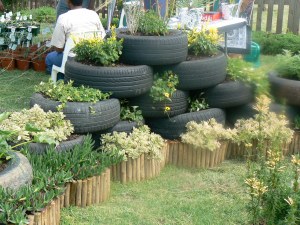
I was accompanying my husband on a business trip in Zanzibar, and having nothing to do in my air-conditioned hotel room,decided to engage a driver who could show me how the people of Zanzibar grew their food. I found a guide who spoke English reasonably well and tried to explain what I was after. He looked at me rather blankly……”Oh, you want the spice tour,” he said, and without further ado we set off in his car. I kept on demanding “food gardens” and he kept on insisting “spice tour” until eventually I gave up.
We arrived at a small farmstead, which consisted of a collection of huts surrounded by palm trees next to the potholed road. Here I was introduced to a young man who told me that he would be explaining the value of all the spices to me, adding that he was not officially a guide, but he needed to practice his English. “Where did he learn about the plants?” I asked, thinking that I would prefer to have an official guide. Noting my hesitation the “guide” flatly informed me that in Zanzibar you did not have to “learn about plants”. You just grew up with them, and that was sufficient.
So we set off into a forest of very beautiful trees interspersed with tall palms. First stop……a henna tree. “This is where the leaves have been harvested and you can see the new leaves coming,” our guide explained. “On the other side the tree looks very different: that is where the leave will be harvested from next time.” All around the henna tree were bunches of lemon grass. “The grass is collected and used fresh for making tea, or dried and bundled so that it can be burned and the smoke used as an insect repellent. The stems are collected for cooking, and for making a body lotion.” The guide’s English was excellent and I was becoming more and more interested. He pointed to another clump of plants next to the footpath, and laughingly asked me to guess what they were. Turmeric. Again the many uses were explained – both culinary and medicinal.
 The forest was refreshingly cool. The trees – clove, cinnamon, litchi, nutmeg and many others I did not recognise, cast a dappled shade, and here and there were small clearings with lemon grass, turmeric, ginger, cardamom and cassava. The forest floor was carpeted with leaves, old palm fronds, and coconut husks. Palm trees grew everywhere: some with creepers full of peppercorns waiting to be picked clinging to their trunks, whilst others supported creepers festooned with vanilla pods.
The forest was refreshingly cool. The trees – clove, cinnamon, litchi, nutmeg and many others I did not recognise, cast a dappled shade, and here and there were small clearings with lemon grass, turmeric, ginger, cardamom and cassava. The forest floor was carpeted with leaves, old palm fronds, and coconut husks. Palm trees grew everywhere: some with creepers full of peppercorns waiting to be picked clinging to their trunks, whilst others supported creepers festooned with vanilla pods.
A farmer, together with a party of children arrived. There were greetings of “Jumbo” all round. The farmer asked if I would like something to drink, kicked off his shoes, grabbed a figure-of-eight shaped piece of rope and proceeded to climb up a coconut palm – at least three story’s high. “Hakuna matata – huh.” The farmer’s voice rang out as he climbed rhythmically up the palm’s stem. “Hakuna matata” the guide and the children shouted back, clapping their hands and dancing from side to side as the farmer climbed higher and higher. I would have loved to sing along, but since I didn’t know the words I had to be content with merely clapping to the rhythm. On reaching the top, the farmer pulled a sharp knife from his belt and hacked down some coconuts and a palm frond.
We relaxed in the sun while the coconuts were prepared: the husk is cut back and then the top lopped off with a sharp knife to form a cup containing coconut juice. We gratefully quenched our thirst – the juice was refreshing and delicious and quite unlike the taste of dried coconut that I was expecting. “Very good for cleaning the kidneys” the guide informed me. As each coconut was drained the farmer carved a spoon out of the coconut husk so that we could scoop out and eat the coconut flesh. What a feast!
In the meantime one of the children was weaving a most beautiful basket out of the coconut frond. As we finished each cocnut we simply threw the husks back into the forest. Mulch! The next tree was a litchi tree, and a young man obligingly harvested several handfuls which were put in the basket for me to take home. The children were now fashioning jewelry out of palm fronds, and I gained several necklaces and a bracelet.
We reached an opening in the forest, and the farmer asked us if we would like to join him at his restaurant: a shady tree furnished with simple benches. The fare consisted of lemons, oranges, star-fruit, guava, cocoa, custard apples, star apples, and jackfruit, one delicious mouthful after another, simply cut up with a very sharp knife, and handed out piece by piece – no cutlery or crockery required. At the end of this sumptuous meal we were brought a container of water and invited to wash our hands – over a chilli bush growing in the middle of the restaurant.

So, I had got my “food garden” experience after all. Not only that, I had been thoroughly entertained, heard a beautiful song, and been given a perfect little basket and loads of jewelry. I had learned a lot about spices, and had been part of a young man’s English lessons. I had feasted on fruit in a beautiful restaurant, and felt good about the fact that not only did no-one have to clean up after me, but I had watered a chilli-bush whilst there.
Back at the hotel, with no forest to keep me cool, it was so hot that I had to jump into a cold shower and switch on the air conditioner. Suddenly, my “civilized” world felt rather empty.





